2007 ISUZU KB P190 sensor
[x] Cancel search: sensorPage 2367 of 6020
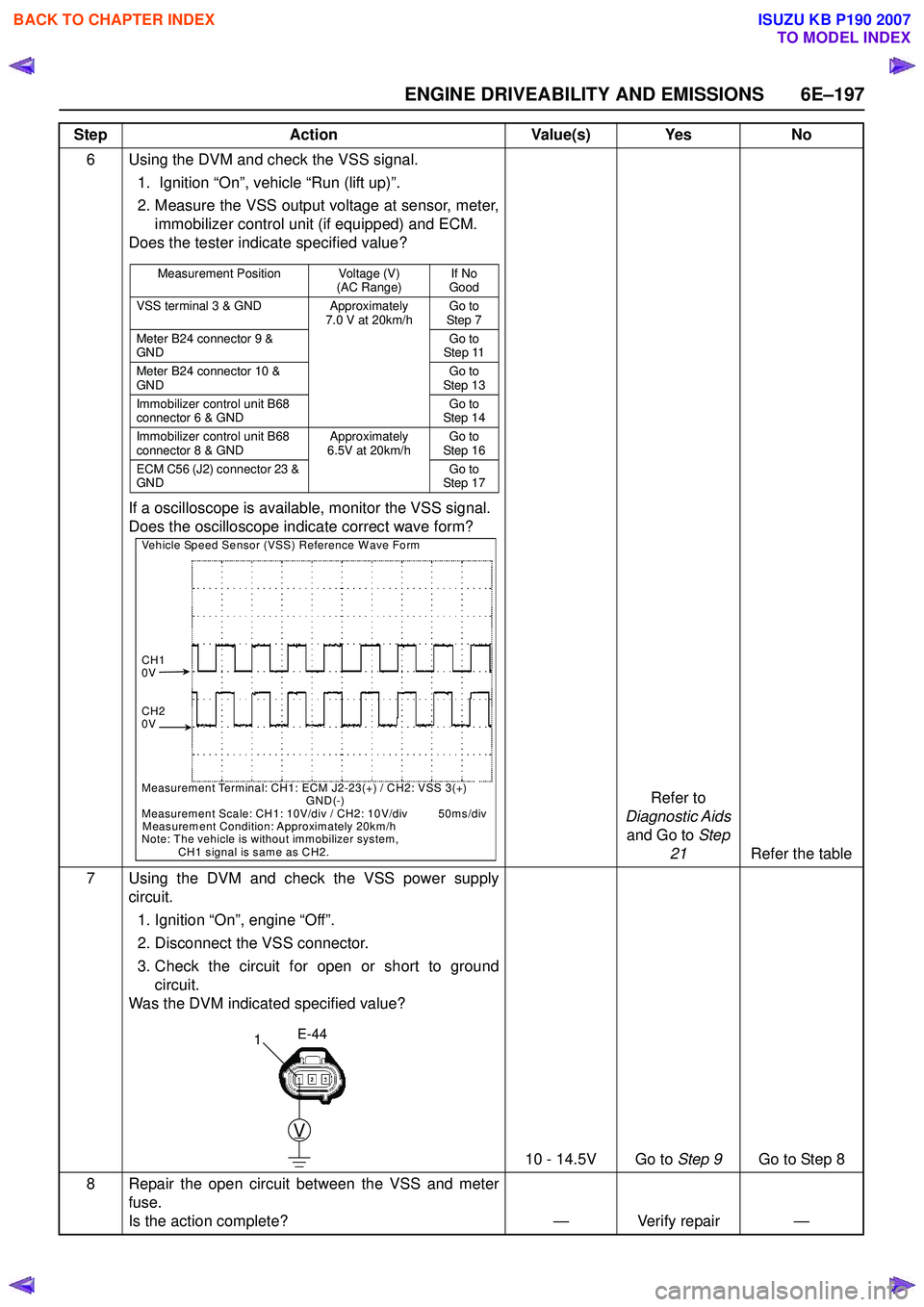
ENGINE DRIVEABILITY AND EMISSIONS 6E–197
6 Using the DVM and check the VSS signal.1. Ignition “On”, vehicle “Run (lift up)”.
2. Measure the VSS output voltage at sensor, meter, immobilizer control unit (if equipped) and ECM.
Does the tester indicate specified value?
If a oscilloscope is available, monitor the VSS signal.
Does the oscilloscope indicate correct wave form?
Refer to
Diagnostic Aids
and Go to Step
21 Refer the table
7 Using the DVM and check the VSS power supply circuit.
1. Ignition “On”, engine “Off”.
2. Disconnect the VSS connector.
3. Check the circuit for open or short to ground circuit.
Was the DVM indicated specified value?
10 - 14.5V Go to Step 9Go to Step 8
8 Repair the open circuit between the VSS and meter fuse.
Is the action complete? — Verify repair —
Step
Action Value(s) Yes No
Measurement Position Voltage (V)
(AC Range)If No
Good
VSS terminal 3 & GND Approximately 7.0 V at 20km/hGo to
Step 7
Meter B24 connector 9 &
GND Go to
Step 11
Meter B24 connector 10 &
GND Go to
Step 13
Immobilizer control unit B68
connector 6 & GND Go to
Step 14
Immobilizer control unit B68
connector 8 & GND Approximately
6.5V at 20km/h Go to
Step 16
ECM C56 (J2) connector 23 &
GND Go to
Step 17
Vehicle Speed Sensor (VSS) Reference Wave Form
CH1
0V
CH2
0V
Measurement Terminal: CH1: ECM J2-23(+) / CH2: VSS 3(+)
GND(-)
Measurement Scale: CH1: 10V/div / CH2: 10V/div 50ms/div
Measurement Condition: Approximately 20km/h
Note: The vehicle is without immobilizer system,
CH1 signal is same as CH2.
V
E-44
1
BACK TO CHAPTER INDEX
TO MODEL INDEX
ISUZU KB P190 2007
Page 2381 of 6020
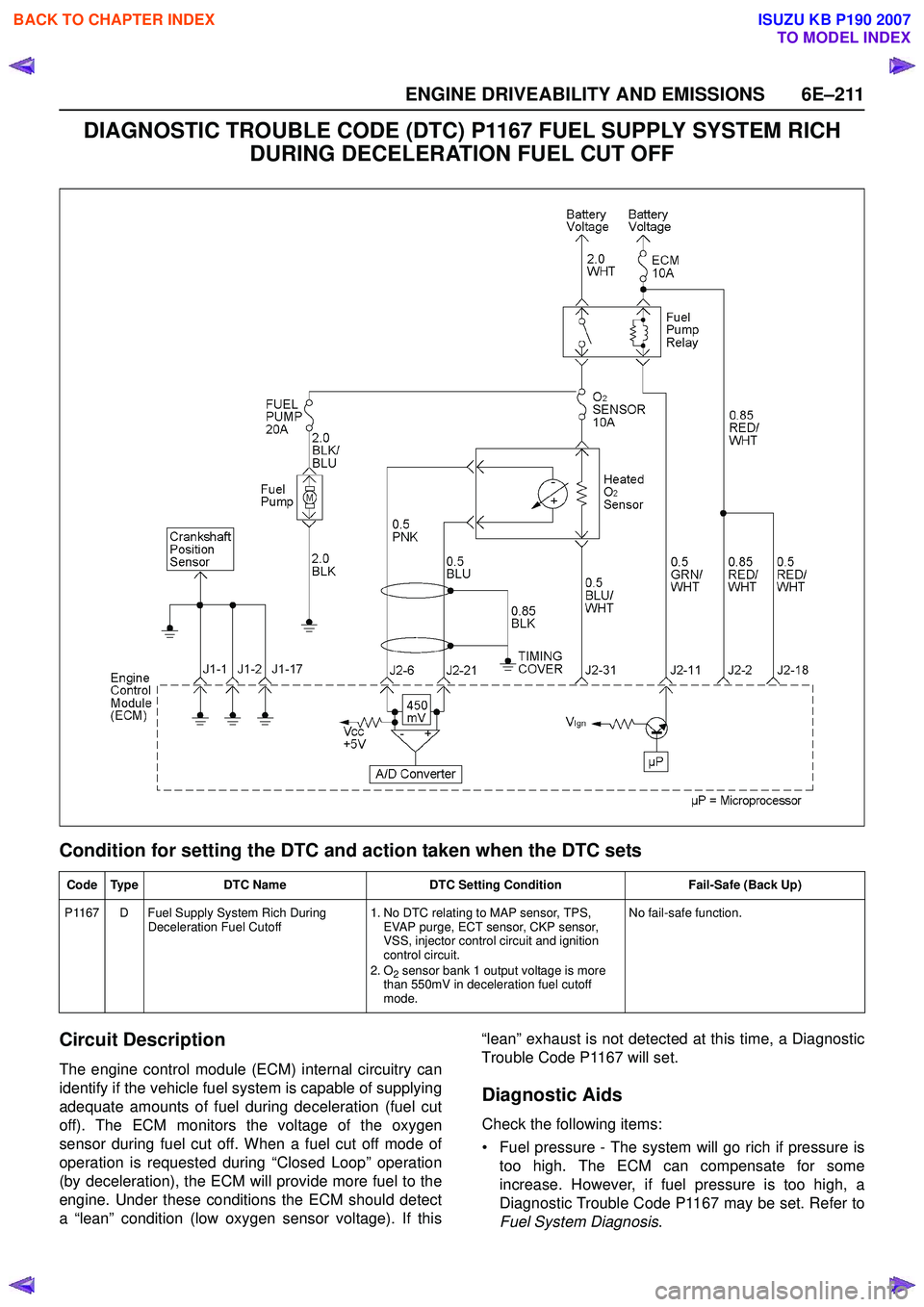
ENGINE DRIVEABILITY AND EMISSIONS 6E–211
DIAGNOSTIC TROUBLE CODE (DTC) P1167 FUEL SUPPLY SYSTEM RICH DURING DECELERATION FUEL CUT OFF
Condition for setting the DTC and action taken when the DTC sets
Circuit Description
The engine control module (ECM) internal circuitry can
identify if the vehicle fuel system is capable of supplying
adequate amounts of fuel during deceleration (fuel cut
off). The ECM monitors the voltage of the oxygen
sensor during fuel cut off. When a fuel cut off mode of
operation is requested during “Closed Loop” operation
(by deceleration), the ECM will provide more fuel to the
engine. Under these conditions the ECM should detect
a “lean” condition (low oxygen sensor voltage). If this “lean” exhaust is not detected at this time, a Diagnostic
Trouble Code P1167 will set.
Diagnostic Aids
Check the following items:
• Fuel pressure - The system will go rich if pressure is too high. The ECM can compensate for some
increase. However, if fuel pressure is too high, a
Diagnostic Trouble Code P1167 may be set. Refer to
Fuel System Diagnosis .
Code Type DTC Name DTC Setting Condition Fail-Safe (Back Up)
P1167 D Fuel Supply System Rich During Deceleration Fuel Cutoff 1. No DTC relating to MAP sensor, TPS,
EVAP purge, ECT sensor, CKP sensor,
VSS, injector control circuit and ignition
control circuit.
2. O
2 sensor bank 1 output voltage is more
than 550mV in deceleration fuel cutoff
mode. No fail-safe function.
BACK TO CHAPTER INDEX
TO MODEL INDEX
ISUZU KB P190 2007
Page 2382 of 6020
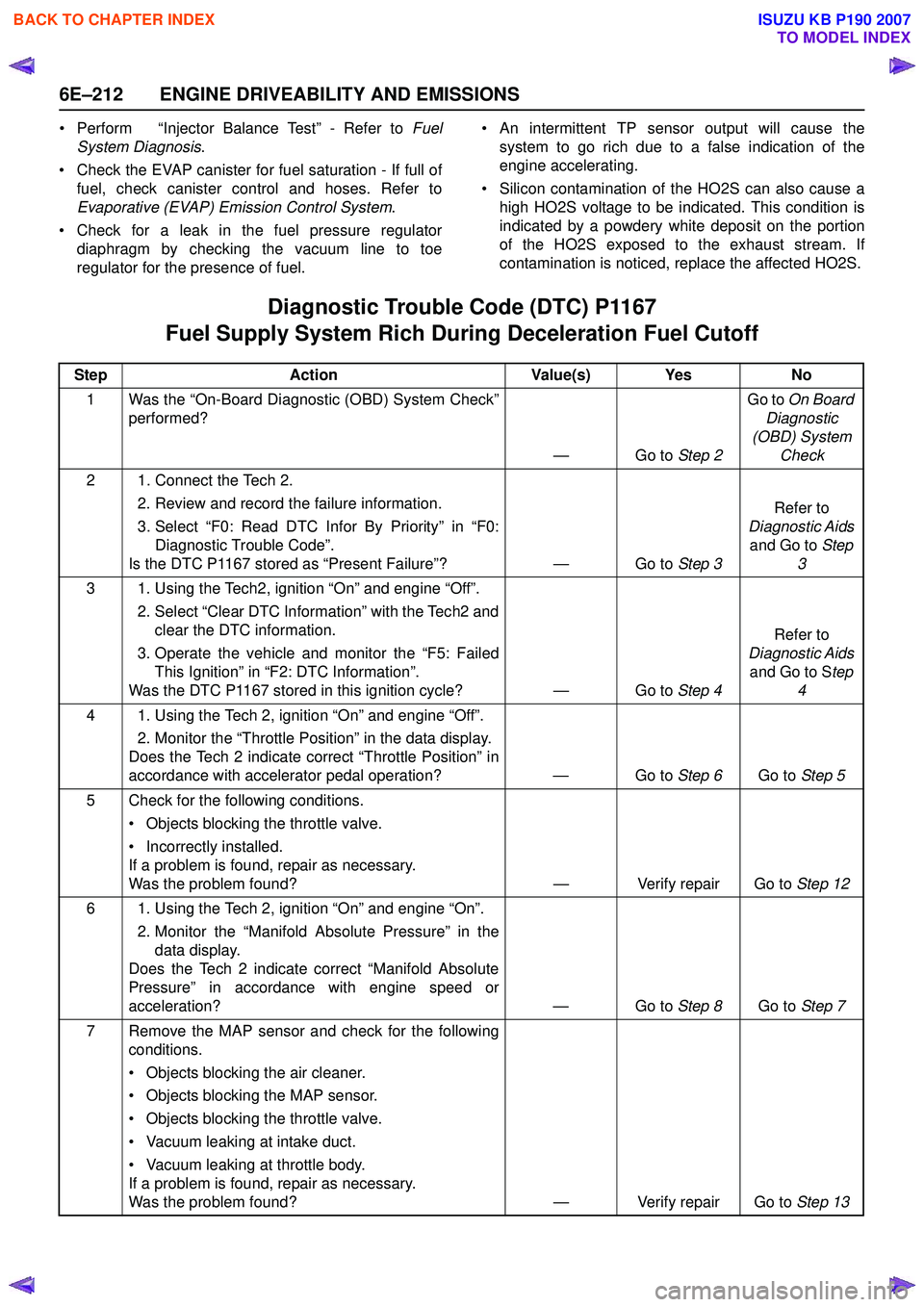
6E–212 ENGINE DRIVEABILITY AND EMISSIONS
• Perform “Injector Balance Test” - Refer to Fuel
System Diagnosis .
• Check the EVAP canister for fuel saturation - If full of fuel, check canister control and hoses. Refer to
Evaporative (EVAP) Emission Control System .
• Check for a leak in the fuel pressure regulator diaphragm by checking the vacuum line to toe
regulator for the presence of fuel. • An intermittent TP sensor output will cause the
system to go rich due to a false indication of the
engine accelerating.
• Silicon contamination of the HO2S can also cause a high HO2S voltage to be indicated. This condition is
indicated by a powdery white deposit on the portion
of the HO2S exposed to the exhaust stream. If
contamination is noticed, replace the affected HO2S.
Diagnostic Trouble Code (DTC) P1167
Fuel Supply System Rich During Deceleration Fuel Cutoff
Step Action Value(s) Yes No
1 Was the “On-Board Diagnostic (OBD) System Check” performed?
—Go to Step 2Go to
On Board
Diagnostic
(OBD) System Check
2 1. Connect the Tech 2. 2. Review and record the failure information.
3. Select “F0: Read DTC Infor By Priority” in “F0: Diagnostic Trouble Code”.
Is the DTC P1167 stored as “Present Failure”? — Go to Step 3Refer to
Diagnostic Aids and Go to Step
3
3 1. Using the Tech2, ignition “On” and engine “Off”. 2. Select “Clear DTC Information” with the Tech2 andclear the DTC information.
3. Operate the vehicle and monitor the “F5: Failed This Ignition” in “F2: DTC Information”.
Was the DTC P1167 stored in this ignition cycle? — Go to Step 4Refer to
Diagnostic Aids and Go to S tep
4
4 1. Using the Tech 2, ignition “On” and engine “Off”. 2. Monitor the “Throttle Position” in the data display.
Does the Tech 2 indicate correct “Throttle Position” in
accordance with accelerator pedal operation? — Go to Step 6Go to Step 5
5 Check for the following conditions. • Objects blocking the throttle valve.
• Incorrectly installed.
If a problem is found, repair as necessary.
Was the problem found? — Verify repair Go to Step 12
6 1. Using the Tech 2, ignition “On” and engine “On”. 2. Monitor the “Manifold Absolute Pressure” in thedata display.
Does the Tech 2 indicate correct “Manifold Absolute
Pressure” in accordance with engine speed or
acceleration? — Go to Step 8Go to Step 7
7 Remove the MAP sensor and check for the following conditions.
• Objects blocking the air cleaner.
• Objects blocking the MAP sensor.
• Objects blocking the throttle valve.
• Vacuum leaking at intake duct.
• Vacuum leaking at throttle body.
If a problem is found, repair as necessary.
Was the problem found? — Verify repair Go to Step 13
BACK TO CHAPTER INDEX
TO MODEL INDEX
ISUZU KB P190 2007
Page 2383 of 6020
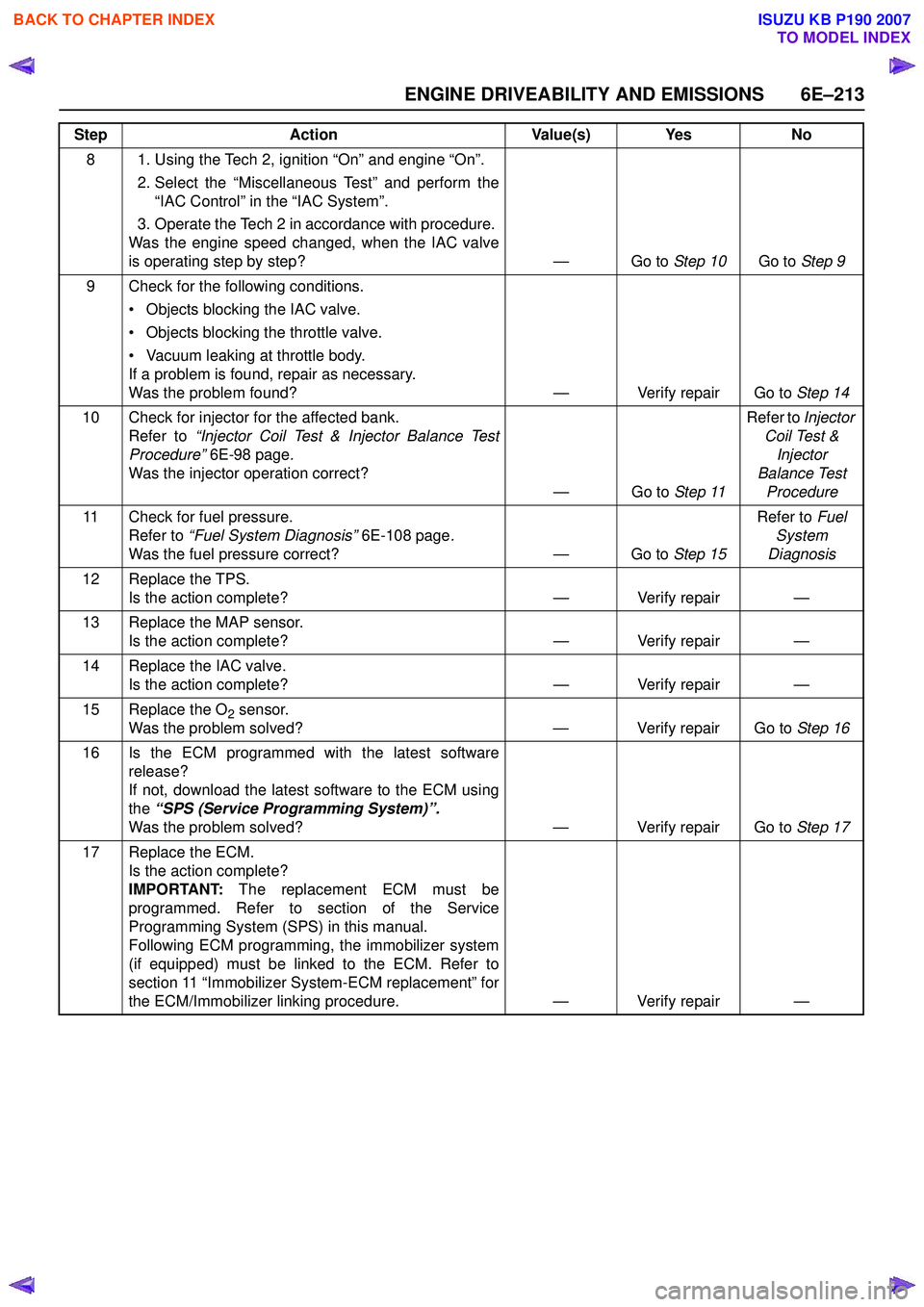
ENGINE DRIVEABILITY AND EMISSIONS 6E–213
8 1. Using the Tech 2, ignition “On” and engine “On”. 2. Select the “Miscellaneous Test” and perform the“IAC Control” in the “IAC System”.
3. Operate the Tech 2 in accordance with procedure.
Was the engine speed changed, when the IAC valve
is operating step by step? — Go to Step 10Go to Step 9
9 Check for the following conditions. • Objects blocking the IAC valve.
• Objects blocking the throttle valve.
• Vacuum leaking at throttle body.
If a problem is found, repair as necessary.
Was the problem found? — Verify repair Go to Step 14
10 Check for injector for the affected bank. Refer to “Injector Coil Test & Injector Balance Test
Procedure” 6E-98 page .
Was the injector operation correct? —Go to Step 11Refer to
Injector
Coil Test & Injector
Balance Test Procedure
11 Check for fuel pressure. Refer to “Fuel System Diagnosis” 6E-108 page.
Was the fuel pressure correct? — Go to Step 15Refer to
Fuel
System
Diagnosis
12 Replace the TPS. Is the action complete? — Verify repair —
13 Replace the MAP sensor. Is the action complete? — Verify repair —
14 Replace the IAC valve. Is the action complete? — Verify repair —
15 Replace the O
2 sensor.
Was the problem solved? — Verify repair Go to Step 16
16 Is the ECM programmed with the latest software release?
If not, download the latest software to the ECM using
the “SPS (Service Programming System)”.
Was the problem solved? — Verify repair Go to Step 17
17 Replace the ECM. Is the action complete?
IMPORTANT: The replacement ECM must be
programmed. Refer to section of the Service
Programming System (SPS) in this manual.
Following ECM programming, the immobilizer system
(if equipped) must be linked to the ECM. Refer to
section 11 “Immobilizer System-ECM replacement” for
the ECM/Immobilizer linking procedure. — Verify repair —
Step
Action Value(s) Yes No
BACK TO CHAPTER INDEX
TO MODEL INDEX
ISUZU KB P190 2007
Page 2384 of 6020
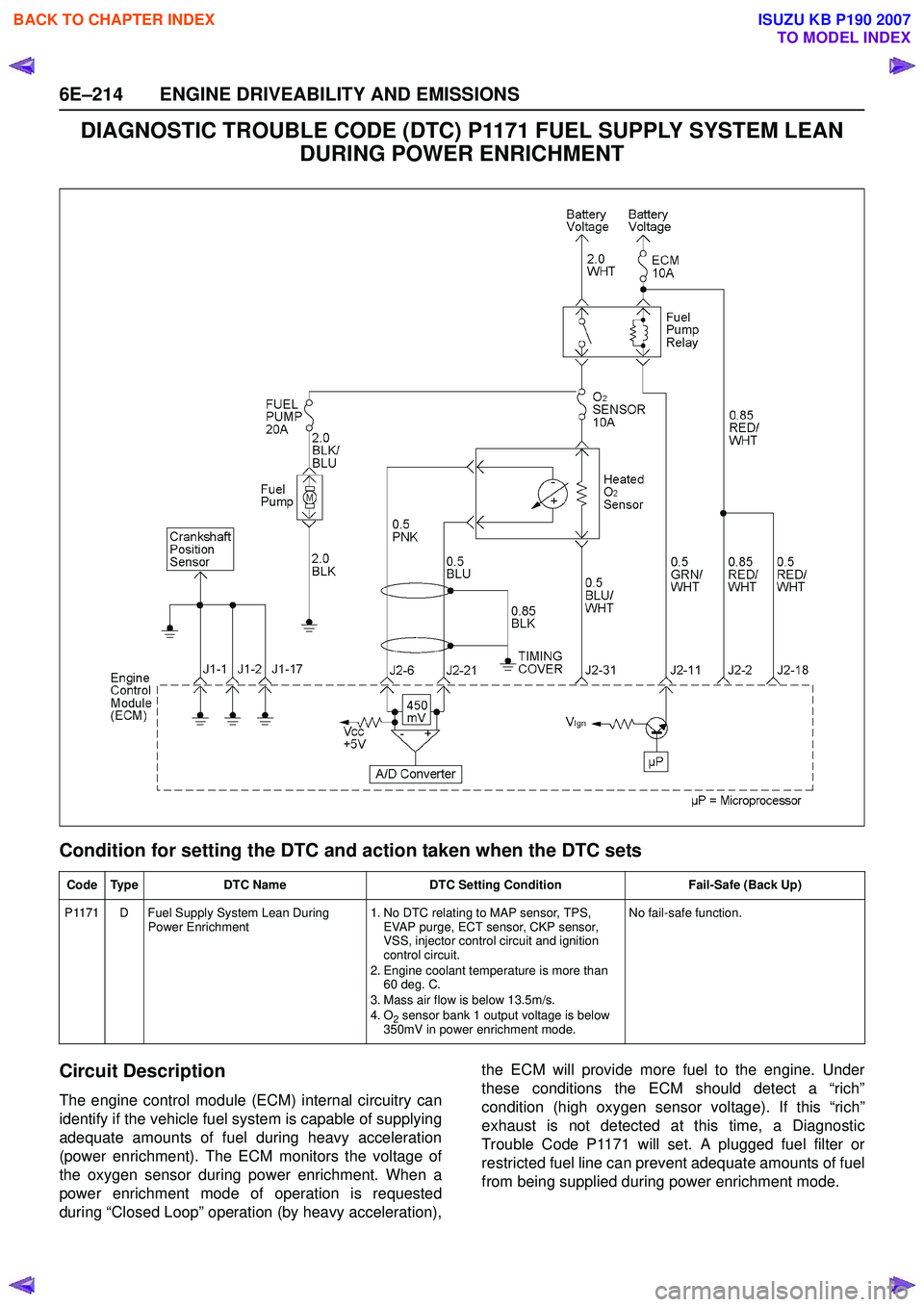
6E–214 ENGINE DRIVEABILITY AND EMISSIONS
DIAGNOSTIC TROUBLE CODE (DTC) P1171 FUEL SUPPLY SYSTEM LEAN DURING POWER ENRICHMENT
Condition for setting the DTC and action taken when the DTC sets
Circuit Description
The engine control module (ECM) internal circuitry can
identify if the vehicle fuel system is capable of supplying
adequate amounts of fuel during heavy acceleration
(power enrichment). The ECM monitors the voltage of
the oxygen sensor during power enrichment. When a
power enrichment mode of operation is requested
during “Closed Loop” operation (by heavy acceleration), the ECM will provide more fuel to the engine. Under
these conditions the ECM should detect a “rich”
condition (high oxygen sensor voltage). If this “rich”
exhaust is not detected at this time, a Diagnostic
Trouble Code P1171 will set. A plugged fuel filter or
restricted fuel line can prevent adequate amounts of fuel
from being supplied during power enrichment mode.
Code Type DTC Name DTC Setting Condition Fail-Safe (Back Up)
P1171 D Fuel Supply System Lean During Power Enrichment 1. No DTC relating to MAP sensor, TPS,
EVAP purge, ECT sensor, CKP sensor,
VSS, injector control circuit and ignition
control circuit.
2. Engine coolant temperature is more than 60 deg. C.
3. Mass air flow is below 13.5m/s.
4. O
2 sensor bank 1 output voltage is below
350mV in power enrichment mode. No fail-safe function.
BACK TO CHAPTER INDEX
TO MODEL INDEX
ISUZU KB P190 2007
Page 2385 of 6020
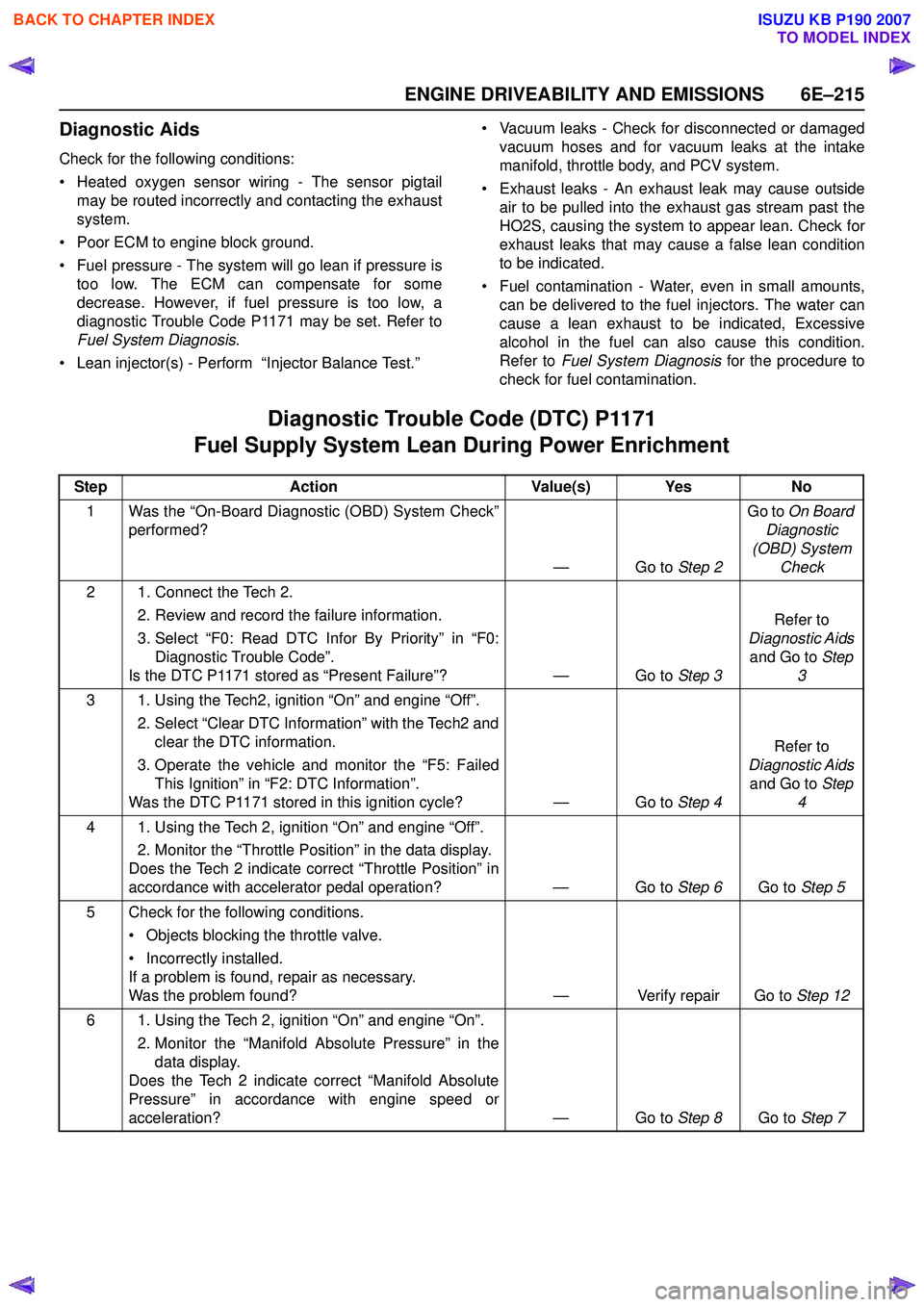
ENGINE DRIVEABILITY AND EMISSIONS 6E–215
Diagnostic Aids
Check for the following conditions:
• Heated oxygen sensor wiring - The sensor pigtail may be routed incorrectly and contacting the exhaust
system.
• Poor ECM to engine block ground.
• Fuel pressure - The system will go lean if pressure is too low. The ECM can compensate for some
decrease. However, if fuel pressure is too low, a
diagnostic Trouble Code P1171 may be set. Refer to
Fuel System Diagnosis .
• Lean injector(s) - Perform “Injector Balance Test.” • Vacuum leaks - Check for disconnected or damaged
vacuum hoses and for vacuum leaks at the intake
manifold, throttle body, and PCV system.
• Exhaust leaks - An exhaust leak may cause outside air to be pulled into the exhaust gas stream past the
HO2S, causing the system to appear lean. Check for
exhaust leaks that may cause a false lean condition
to be indicated.
• Fuel contamination - Water, even in small amounts, can be delivered to the fuel injectors. The water can
cause a lean exhaust to be indicated, Excessive
alcohol in the fuel can also cause this condition.
Refer to Fuel System Diagnosis for the procedure to
check for fuel contamination.
Diagnostic Trouble Code (DTC) P1171
Fuel Supply System Lean During Power Enrichment
Step Action Value(s) Yes No
1 Was the “On-Board Diagnostic (OBD) System Check” performed?
—Go to Step 2Go to
On Board
Diagnostic
(OBD) System Check
2 1. Connect the Tech 2. 2. Review and record the failure information.
3. Select “F0: Read DTC Infor By Priority” in “F0: Diagnostic Trouble Code”.
Is the DTC P1171 stored as “Present Failure”? — Go to Step 3Refer to
Diagnostic Aids and Go to Step
3
3 1. Using the Tech2, ignition “On” and engine “Off”. 2. Select “Clear DTC Information” with the Tech2 andclear the DTC information.
3. Operate the vehicle and monitor the “F5: Failed This Ignition” in “F2: DTC Information”.
Was the DTC P1171 stored in this ignition cycle? — Go to Step 4Refer to
Diagnostic Aids and Go to Step
4
4 1. Using the Tech 2, ignition “On” and engine “Off”. 2. Monitor the “Throttle Position” in the data display.
Does the Tech 2 indicate correct “Throttle Position” in
accordance with accelerator pedal operation? — Go to Step 6Go to Step 5
5 Check for the following conditions. • Objects blocking the throttle valve.
• Incorrectly installed.
If a problem is found, repair as necessary.
Was the problem found? — Verify repair Go to Step 12
6 1. Using the Tech 2, ignition “On” and engine “On”. 2. Monitor the “Manifold Absolute Pressure” in thedata display.
Does the Tech 2 indicate correct “Manifold Absolute
Pressure” in accordance with engine speed or
acceleration? — Go to Step 8Go to Step 7
BACK TO CHAPTER INDEX
TO MODEL INDEX
ISUZU KB P190 2007
Page 2386 of 6020
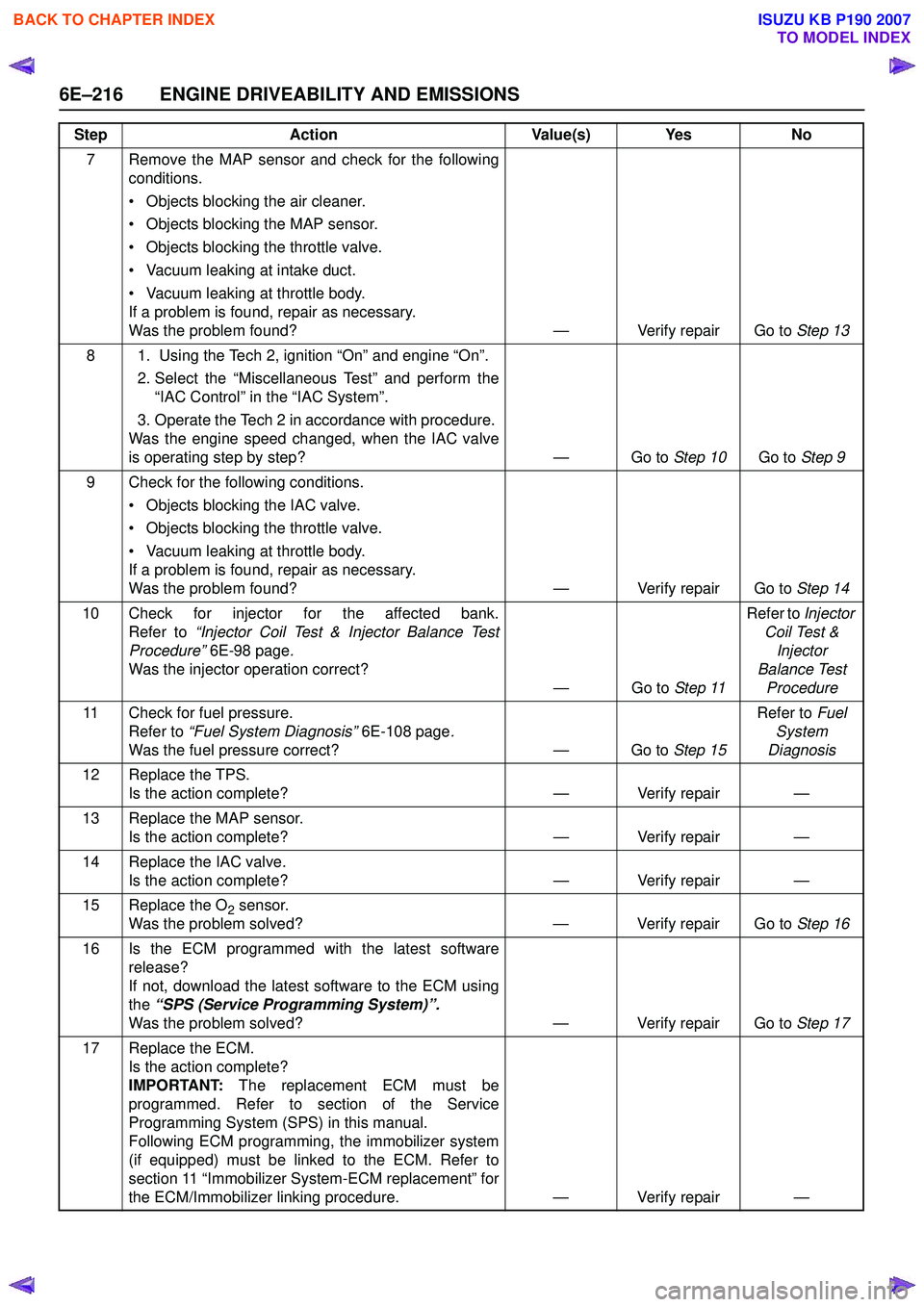
6E–216 ENGINE DRIVEABILITY AND EMISSIONS
7 Remove the MAP sensor and check for the followingconditions.
• Objects blocking the air cleaner.
• Objects blocking the MAP sensor.
• Objects blocking the throttle valve.
• Vacuum leaking at intake duct.
• Vacuum leaking at throttle body.
If a problem is found, repair as necessary.
Was the problem found? — Verify repair Go to Step 13
8 1. Using the Tech 2, ignition “On” and engine “On”. 2. Select the “Miscellaneous Test” and perform the“IAC Control” in the “IAC System”.
3. Operate the Tech 2 in accordance with procedure.
Was the engine speed changed, when the IAC valve
is operating step by step? — Go to Step 10Go to Step 9
9 Check for the following conditions. • Objects blocking the IAC valve.
• Objects blocking the throttle valve.
• Vacuum leaking at throttle body.
If a problem is found, repair as necessary.
Was the problem found? — Verify repair Go to Step 14
10 Check for injector for the affected bank. Refer to “Injector Coil Test & Injector Balance Test
Procedure” 6E-98 page .
Was the injector operation correct? —Go to Step 11Refer to
Injector
Coil Test & Injector
Balance Test Procedure
11 Check for fuel pressure. Refer to “Fuel System Diagnosis” 6E-108 page.
Was the fuel pressure correct? — Go to Step 15Refer to
Fuel
System
Diagnosis
12 Replace the TPS. Is the action complete? — Verify repair —
13 Replace the MAP sensor. Is the action complete? — Verify repair —
14 Replace the IAC valve. Is the action complete? — Verify repair —
15 Replace the O
2 sensor.
Was the problem solved? — Verify repair Go to Step 16
16 Is the ECM programmed with the latest software release?
If not, download the latest software to the ECM using
the “SPS (Service Programming System)”.
Was the problem solved? — Verify repair Go to Step 17
17 Replace the ECM. Is the action complete?
IMPORTANT: The replacement ECM must be
programmed. Refer to section of the Service
Programming System (SPS) in this manual.
Following ECM programming, the immobilizer system
(if equipped) must be linked to the ECM. Refer to
section 11 “Immobilizer System-ECM replacement” for
the ECM/Immobilizer linking procedure. — Verify repair —
Step
Action Value(s) Yes No
BACK TO CHAPTER INDEX
TO MODEL INDEX
ISUZU KB P190 2007
Page 2398 of 6020
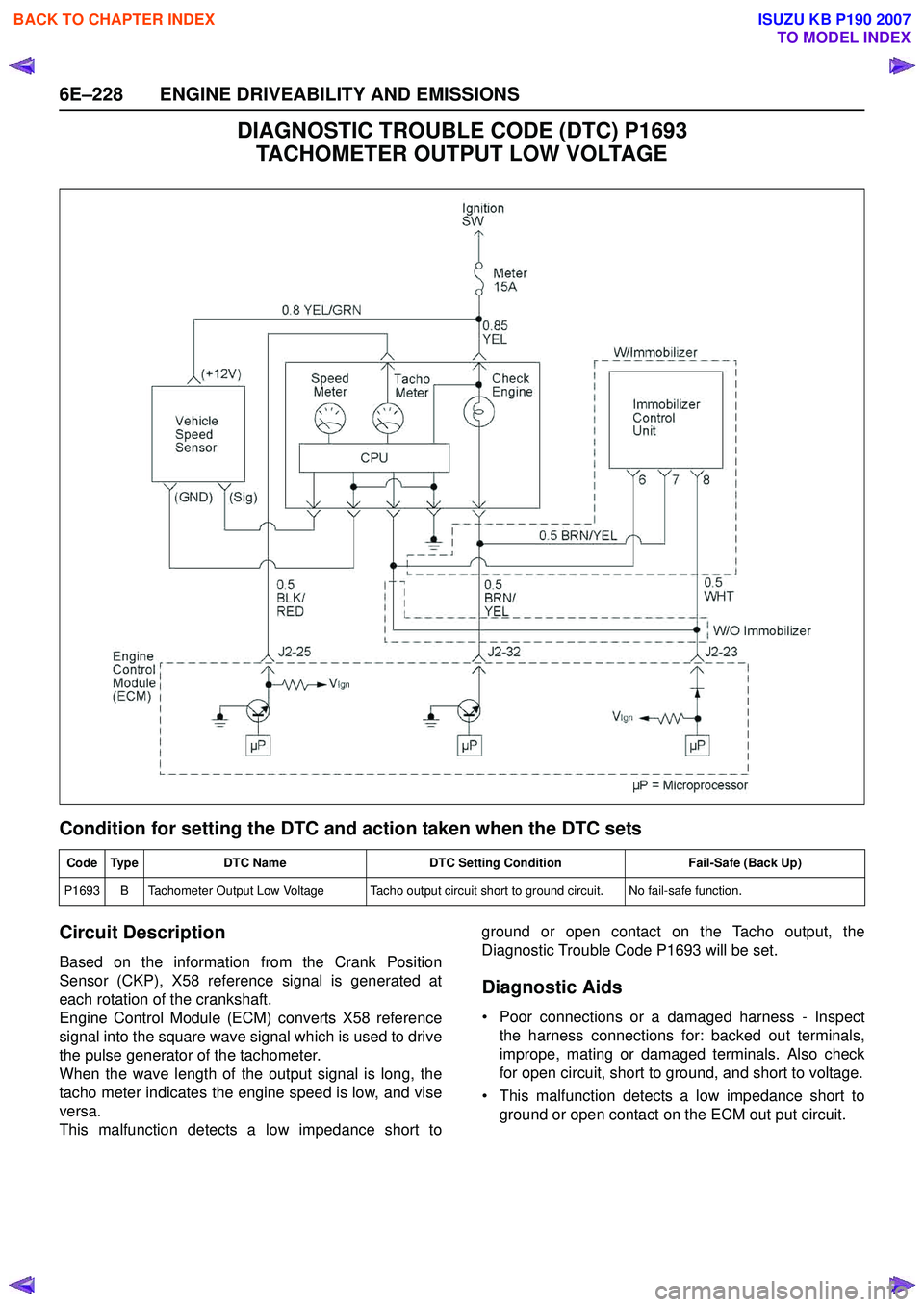
6E–228 ENGINE DRIVEABILITY AND EMISSIONS
DIAGNOSTIC TROUBLE CODE (DTC) P1693 TACHOMETER OUTPUT LOW VOLTAGE
Condition for setting the DTC and action taken when the DTC sets
Circuit Description
Based on the information from the Crank Position
Sensor (CKP), X58 reference signal is generated at
each rotation of the crankshaft.
Engine Control Module (ECM) converts X58 reference
signal into the square wave signal which is used to drive
the pulse generator of the tachometer.
When the wave length of the output signal is long, the
tacho meter indicates the engine speed is low, and vise
versa.
This malfunction detects a low impedance short to ground or open contact on the Tacho output, the
Diagnostic Trouble Code P1693 will be set.
Diagnostic Aids
• Poor connections or a damaged harness - Inspect the harness connections for: backed out terminals,
imprope, mating or damaged terminals. Also check
for open circuit, short to ground, and short to voltage.
• This malfunction detects a low impedance short to ground or open contact on the ECM out put circuit.
Code Type DTC Name DTC Setting Condition Fail-Safe (Back Up)
P1693 B Tachometer Output Low Voltage Tacho output circuit short to ground circuit. No fail-safe function.
BACK TO CHAPTER INDEX
TO MODEL INDEX
ISUZU KB P190 2007